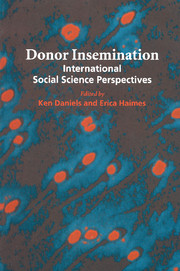Book contents
- Frontmatter
- Contents
- List of figures
- List of tables
- Notes on contributors
- Acknowledgements
- List of abbreviations
- 1 International social science perspectives on donor insemination: an introduction
- 2 The users of donor insemination
- 3 Families created through donor insemination
- 4 The making of ‘the DI child’: changing representations of people conceived through donor insemination
- 5 The semen providers
- 6 The medical management of donor insemination
- 7 Regulation of donor insemination
- 8 Donor insemination and ‘public opinion’
- 9 Concluding comments
- Index
7 - Regulation of donor insemination
Published online by Cambridge University Press: 04 August 2010
- Frontmatter
- Contents
- List of figures
- List of tables
- Notes on contributors
- Acknowledgements
- List of abbreviations
- 1 International social science perspectives on donor insemination: an introduction
- 2 The users of donor insemination
- 3 Families created through donor insemination
- 4 The making of ‘the DI child’: changing representations of people conceived through donor insemination
- 5 The semen providers
- 6 The medical management of donor insemination
- 7 Regulation of donor insemination
- 8 Donor insemination and ‘public opinion’
- 9 Concluding comments
- Index
Summary
Introduction
This chapter shifts attention to the public policy context of DI and to the question of what role, if any, governments ought to play in regulating fertility and infertility services. After briefly discussing the wide range of approaches for organising, monitoring, and regulating DI services, it explicitly contrasts the professional model with public regulatory models. The role of the public regarding technological applications in a democracy is analysed. It is argued that while the issues raised by DI make it a matter of public concern and that some form of public accountability is essential, there are dangers to excessive public control of DI services. Attention then turns to a description of current regulatory strategies both within and across nations. The UK Human Fertilisation and Embryology Authority is examined in detail as a model for a state licensing authority. The chapter concludes by proposing a regulatory approach that combines elements from both professional and public models.
Justifying intervention and regulation in the practice of donor insemination
Although DI itself is a simple technique, it is critical to note that it does not stand alone in practice but rather must be seen in combination with other more intrusive and costly assisted reproductive technology (ART) techniques. It is only one of many services provided by most fertility clinics and, thus, will generally be included with them in any guidelines or regulations.
- Type
- Chapter
- Information
- Donor InseminationInternational Social Science Perspectives, pp. 131 - 150Publisher: Cambridge University PressPrint publication year: 1998
- 7
- Cited by



